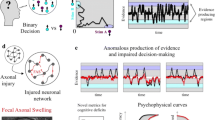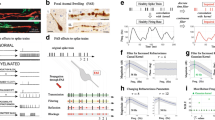Abstract
Axonal swellings are almost universal in neurodegenerative diseases of the central nervous system, including Alzheimer’s and Parkinson’s disease. Concussions and traumatic brain injuries can also produce cognitive and behavioral deficits by compromising neuronal morphology. Using a spike metric analysis, we characterize computationally the effects of such axonal varicosities on spike train propagation by comparing Poisson spike train classes before and after propagation through a prototypical axonal enlargement, or focused axonal swelling. Misclassification of spike train classes and low-pass filtering of firing rate activity increases with more pronounced axonal injury. We show that confusion matrices and a calculation of the loss of transmitted information provide a very practical way to characterize how injured neurons compromise the signal processing and faithful conductance of spike trains. The method demonstrates that (i) neural codes encoded with low firing rates are more robust to injury than those encoded with high firing rates, (ii) classification depends upon the length of the spike train used to encode information, and (iii) axonal injuries reduce the variance of spike trains within a given stimulus class. The work introduces a novel theoretical and computational framework to quantify the interplay between electrophysiological dynamics with focused axonal swellings generated by injury or other neurodegenerative processes. It further suggests how pharmacology and plasticity may play a role in recovery of neural computation. Ultimately, the work bridges vast experimental observations of in vitro morphological pathologies with post-traumatic cognitive and behavioral dysfunction.








Similar content being viewed by others
References
Fainaru-Wada, M., & Fainaru, S. (2013). League of denial: The NFL, concussions, and the battle for truth. Crown Archetype.
Faul, M., Xu, L., Wald, M.M., Coronado, V.G. (2010). Traumatic brain injury in the United States: emergency department visits, hospitalizations, and deaths. Atlanta (GA): centers for disease control and prevention, national center for injury prevention and control.
Adle-Biassette, H., Chretien, F., Wingertsmann, L., Hery, C., Ereau T., Scaravilli, F., Tardieu, M., Gray, F. (1999). Neuropathology and Applied Neurobiology, 25, 123–133.
Altenberger, R., Lindsay, K.A., Ogden, J.M., Rosenberg, J.R. (2001). The interaction between membrane kinetics and membrane geometry in the transmission of action potentials in non-uniform excitable fibres: a finite element approach. Journal of Neuroscience Methods, 112, 101–117.
Antic, S., Wuskell, J.P., Loew, L., Zecevic, D. (2000). Functional profile of the giant metacerebral neuron of Helix aspersa: temporal and spatial dynamics of electrical activity in situ. The Journal of Physiology, 527, 55–69.
Aronov, D., & Victor, J.D. (2005). Non-euclidean properties of spike train metric spaces. Physical Reviews E - Statistics Nonlin Soft Matter Physical, 69, 061905.
Bakkum, D.J., Frey, U., Radivojevic, M., Russel, T.L., Müller. J., Fiscella, M., Takahashi, H., Hierlemann, A. (2013). Nature communications, 4, 2181.
Blumbergs, P.C., Scott, G., Manavis, J., Wainwright, H., Simpson, D.A., McLean, A.J (1995). Topography of axonal injury as defined by amyloid precursor protein and the sector scoring method in mild and severe closed head injury. Journal of Neurotrauma, 12, 565–572.
Browne, K.D., Chen, X.H., Meaney, D.F., Smith, D.H. (2011). Mild traumatic brain injury and diffuse axonal injury, in Swine. Journal of Neurotrauma, 28(9), 1747–1755.
Bucher, D., & Goaillard, J.M. (2011). Beyond faithful conduction: Short term dynamics, neuromodulation, and long-term regulation of spike propagation in the axon. Progress in Neurobiology, 94, 307–346.
Chen, W.R., Shen, G.Y., Shepherd, G.M., Hines, M.L., Midtgaard, J. (2002). Multiple modes of action potential initiation and propagation in mitral cell primary dendrite. Journal of Neurophysiology, 88, 27552764.
Chen, Y.C., Smith, D.H., Meaney, D.F. (2009). In-Vitro approaches for studying blast-induced traumatic brain injury. Journal of Neurotrauma, 26(6), 861–876.
Christman, C.W., Grady, M.S., Walker, S.A., Hol-Loway, K.L., Povlishock, J.T. (1994). Ultra-structural studies of diffuse axonal injury in humans. Journal of Neurotrauma, 11, 173–186.
Cheng, C.L., & Povlishock, J.T. (1988). The effect of traumatic brain injury on the visual system: a morphologic characterization of reactive axonal change. Journal of Neurotrauma, 5, 47–60.
Dayan, P., & Abbot, F.L. (2001). Theoretical Neuroscience. MIT Press.
Coleman, M. (2005). Axon degeneration mechanisms: commonality amid diversity. Nature Reviews Neuroscience, 6(11), 889–898.
Debanne, D. (2004). Information processing in the axon. Nature Reviews Neuroscience, 5(4), 304–316.
Debanne, D., Campanac, E., Bialowas, A. (2011). Axon Physiology. Physiological Reviews, 91, 555–602.
Ermentrout, G.B., & Rinzel, J. (1996). Reflected waves in an inhomogeneous excitable medium. SIAM Journal on Applied Mathematics, 56(4), 1107–1128.
Ermentrout, G.B. (2010). Mathematical foundations of neuroscience: Springer.
Ferguson, B., Matyszak, M.K., Esiri, M.M., Perry, V.H. (1997). Axonal damage in acute multiple sclerosis lesions. Brain, 120, 393–399.
Fitzhugh, R. (1961). Impulses and physiological states in theoretical models of nerve membrane. Biophysical Journal, 1(6), 445–466.
Galvin, J.E., Uryu, K., Lee, V.M., Trojanowski, J.Q. (1999). Axon pathology in parkinsons disease and lewy body dementia hippocampus contains α-, β-, and γ -synuclein. Proceedings of National Academy of Science (USA), 96, 13450–13455.
Gerstner, W. (2002). Spiking neuron models. Cambridge University Press.
Goldstein, S.S., & Rall, W. (1974). Changes of action potential shape and velocity for changing core conductor geometry. Biophysical Journal, 14, 731–757.
Grady, M.S., Mclaughlin, M.R., Christman, C.W., Valadaka, A.B., Flinger, C.L., Povlishock, J.T. (1993). The use of antibodies against neurofilament sub- units for the detection of diffuse axonal injury in humans. Journal of Neuropathology Experimentalis Neurologica, 52, 143–152.
Hemphill, M.A., Dabiri, B.E., Gabriele, S., Kerscher, L., Franck, C., Goss, J.A., Alford, P.W., Parker, K.K. (2011). A possible role for integrin signaling in diffuse axonal injury. PLos ONE, 6(7), 22899.
Hodgkin, A.L., & Huxley, A.F. (1952). A quantitative description of membrane current and its application to conduction and excitation in nerve. The Journal of Physiology, 117(4), 500–545.
Izhikevich, E.M. (2007). Dynamical systems in neuroscience: the geometry of excitability and bursting. MIT Press.
Johnson, V.E., Stewart, W., Smith, D.H. (2013). Axonal pathology in traumatic brain injury. Experimental Neurology, 246, 35–43.
Jorge, R.E., Acion, L., White, T., Tordesillas-Gutierrez, D., Pierson, R., Crespo-Facorro, B., Magnotta, V.A. (2012). White matter abnormalities in veterans with mild traumatic brain injury. American Journal of Psychiatry, 169(12), 1284–1291.
Krstic, D., & Knusesl, I. (2012). Deciphering the mechanism underlying late-onset alzheimer disease. Nature Reviews Neuroscience, 9(1), 25–34.
Khodorov, B.I., & Timin, E.N. (1975). Nerve impulse propagation along nonuniform fibres. Progress in Biophysics and Molecular Biology, 30(23), 145–184.
Kutz, J.N. (2013). Data-driven modeling and scientific computing: Oxford Press.
Liberski, P.P., & Budka, H. (1999). Neuroaxonal pathology in Creutzfeldt-Jakob disease. Acta Neuropathology (Berlim), 97, 329–334.
Lipton, M.L., Gellella, E., Lo, C., Gold, T., Ardekani, B.A., Shifteh, K., Bello, J.A., Branch, C.A. (2008). Journal of Neurotrauma, 25, 13351342.
Magdesian, M.H., Sanchez, F.S., Lopez, M., Thostrup, P., Durisic, N., Belkaid, W., Liazoghli, D., Grütter, P., Colman, R. (2012). Atomic force microscopy reveals important differences in axonal resistance to injury. Biophysical Journal, 103(3), 405–414.
Maia, P.D., & Kutz, J.N. (2014). Identifying critical regions for spike propagation in axon segments. Journal of Computational Neuroscience, 36(2), 55–141.
Manor, Y., Koch, C., Segev, I. (1991). Effect of geometrical irregularities on propagation delay in axonal trees. Biophysical Journal, 60, 1424–1437.
Maxwell, W.L., Povlishock, J.T., Graham, D.L. (1997). A mechanistic analysis of nondisruptive axonal injury:A review. Journal of Neurotrauma, 17(7), 419–440.
Millecamps, S., & Julien, J.P. (2013). Axonal transport deficits and neurodegenerative diseases. Nature Reviews Neuroscience, 14(161), 161–176.
Nagumo, S., Arimoto, Yoshizawa, S. (1962). An active pulse transmission line simulating nerve axon. Proceedings of the IRE, 50(10), 2061–2070.
Niogi, S.N., Mukherjee, P., Ghajar, J., Johnson, C., Kolster, R.A., Sarkar, R., Lee, H., Meeker, M., Zimmerman, R.D., Manley, G.T., Mccandliss, B.D. (2008). Extent of Microstructural White Matter Injury in Postconcussive Syndrome Correlates with Impaired Cognitive Reaction Time: A 3T Diffusion Tensor Imaging Study of Mild Traumatic Brain Injury. American Journal of Neuroradiology, 29(5), 967–973.
Parnas, I. (1972). Differential block at high frequency of branches of a single axon innervating two muscles. Journal of Neurophysiology, 35, 903–914.
Parnas, I., Hochstein, S., Parnas, H. (1976). Theoretical analysis of parameters leading to frequency modulation along an inhomogeneous axon. Journal of Neurophysiology, 39(4).
Parnas, I. (1979). Propagation in nonuniform neurites: form and function in axons. The neurosciences, edited by Schmitt, F.O. Worden F.G.Cambridge, MIT Press, 499–512.
Ramon, F., Joyner, R.W, Moore, J.W. (1975). Propagation of action potentials in inhomogeneous axon regions. Federation proceedings, 34, 1357–1363.
Rinzel, J. (1990). Mechanisms for nonuniform propagation along excitable cables. Annals of the New York Academy of Sciences, 591.
Rubovitch, V., Ten-Bosch, M., Zohar, O., Harrison, C.R., Tempel-Brami, C., Stein, E., Hoffer, B.J., Balaban, C., Schreiber, S., Chiu, W.T., Pick, C.G. (2011). A mouse model of blast-induced mild traumatic brain injury. Experimental Neurology, 232(2), 280–289.
Scott, A. (2002). Neuroscience: a mathematical primer: Springer.
Segev, I., & Schneidman, E. (1999). Axons as computing devices: basic insights gained from models. The Journal of Physiology, 93, 263–270.
Shepherd, G.M.G., & Harris, K. (1998). Three-dimensional structure and composition of CA3 to CA1 axons in rat hippocampal slices: implications for presynaptic connectivity and compartmentalization. Journal of Neuroscience, 18(20).
Smith, D.H., Wolf, J.W., Lusardi, T.A., Lee, V.M.Y., Meaney, D.F. (1999). High tolerance and delayed elastic response of cultured axons to dynamic stretch injury. The Journal of Neuroscience, 19(11), 4263–4269.
Smith, D.O. (1980). Mechanisms of action potential propagation failure at sites of axon branching in the crayfish. The Journal of Physiology, 301, 243–259.
Tang-Schomer, M.D., Johnson, V.E., Baas, P.W., Stewart, W., Smith, D.H (2012). Partial interruption of axonal transport due to microtubule breakage accounts for the formation of periodic varicosities after traumatic axonal injury. Experimental Neurology, 233, 364–372.
Tang-Schomer, M.D., Patel, A.R., Bass, P.W., Smith, D.H (2010). Mechanical breaking of microtubules in axons during dynamic stretch injury underlies delayed elasticity, microtubule disassembly, and axon degeneration. The FASEB Journal, 24(5), 1401–1410.
Trapp, B.D., Peterson, J., Ransohoff, R.M., Rudick, R., Mrk, S., B L. (1998). Axonal transection in the lesions of multiple sclerosis. The New England Journal of Medicine, 338, 278–285.
Tsai, J., Grutzendler, J., Duff, K., Gan, W.B. (2004). Fibrillar amyloid deposition leads to local synaptic abnormalities and breakage of neuronal branches. Nature Neuroscience, 7, 1181–1183.
Victor, J.D. (2005). Spike train metrics. Current opinion in Neurobiology, 15, 585–592.
Victor, J.D., & Purpura, K.P. (1997). Metric space analysis of spike trains: theory, algorithms and application. Network: Computational Neural Systems, 8, 127–164.
Wang, J., Hamm, R.J., Povlishock, J.T. (2011). Traumatic axonal injury in the optic nerve: evidence for axonal swelling, disconnection, dieback and reorganization. Journal of Neurotrauma, 28(7), 1185–1198.
Xiong, Y., Mahmood, A., Chopp, M. (2013). Animal models of traumatic brain injury. Nature Reviews Neuroscience, 14(2), 128–142.
Zhou, Y., & Bell, J. (1994). Study of propagation along nonuniform excitable fibers. Mathematical Biosciences, 119(2), 169–203.
Acknowledgments
We are especially grateful to Bingni Brunton, Steven Brunton, Borna Dabiri and Matthew Hemphill for discussions relating to the filtering and functionality of the injured axons. We also thank Eric Shea-Brown, Ben Lansdell and Alex Cayco-Gajic for helpful discussions relating to this work. Finally, we acknowledge our anonymous reviewers for pointing out other neurodegenerative diseases beyond TBI where our work could be potentially applied.
Conflict of interest
The authors declare that they have no conflict of interest.
Author information
Authors and Affiliations
Corresponding author
Additional information
Action Editor: Jonathan David Victor
Grants or other notes about the article that should go on the front page should be placed here. General acknowledgments should be placed at the end of the article.
Rights and permissions
About this article
Cite this article
Maia, P.D., Kutz, J.N. Compromised axonal functionality after neurodegeneration, concussion and/or traumatic brain injury. J Comput Neurosci 37, 317–332 (2014). https://doi.org/10.1007/s10827-014-0504-x
Received:
Revised:
Accepted:
Published:
Issue Date:
DOI: https://doi.org/10.1007/s10827-014-0504-x




